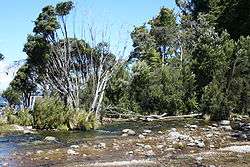Te Ana-au Caves

The Te Ana-au caves are a culturally and ecologically important system of limestone caves on the western shore of Lake Te Anau, in the southwest of New Zealand. It was discovered in 1948 by Lawson Burrows, who found the upper entry after three years of searching, following clues in old Māori legends. It later became a major tourist attraction for the area, as the part of the caverns close to the lake shore is home to glowworms. The unofficial name used by the national caving association is Aurora. The caves are geologically young (estimated 12,000 years)[1] and hence there is only one tiny stalagmite.
The Māori name Te Ana-au can be translated as "The Swirling Cave" (te: the; ana: cave; au: swirling) in reference to the water running through it.[2]
Since the caves lie in the Murchison Mountains (where the endangered takahe were rediscovered), and are themselves very fragile, access is restricted.[3] Commercial guided tours by punt through the water-filled caverns run daily, operated by Real Journeys.
References
- ↑ "Te Anau Glowworm Caves". Real Journeys.
- ↑ "Te Anau". NZHistory. Ministry of Culture and Heritage. Retrieved 25 September 2015.
- ↑ 5.14 Cave and Karst Systems, PDF 2,626K (from the Fiordland National Park Management Plan, June 2007). "Access to the Aurora and Te Ana-au system will be controlled under Specially Protected Area status. One concession is considered appropriate for guiding visitors through Te Ana-au cave ...."
Coordinates: 45°17′43″S 167°43′37″E / 45.2954°S 167.727°E